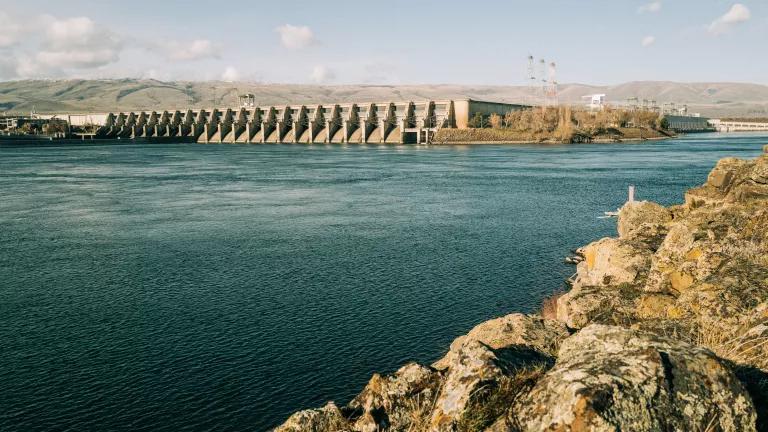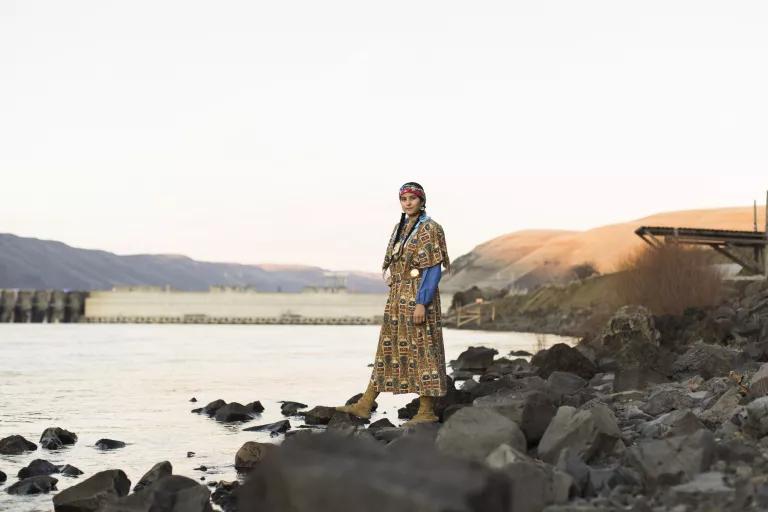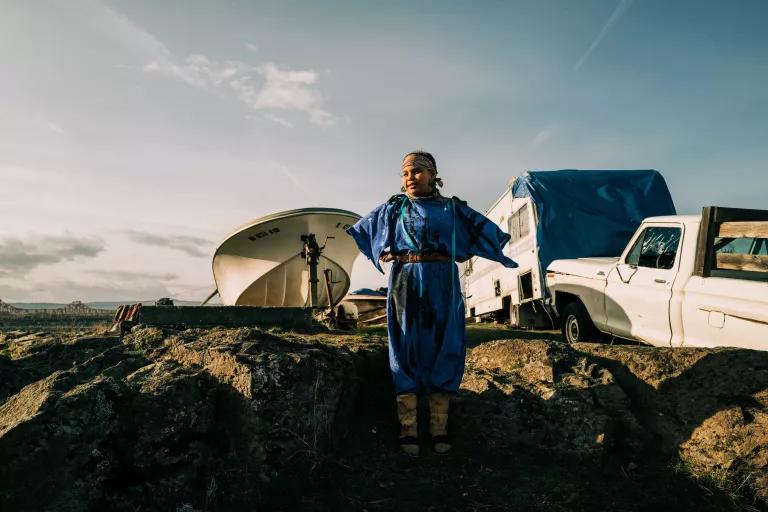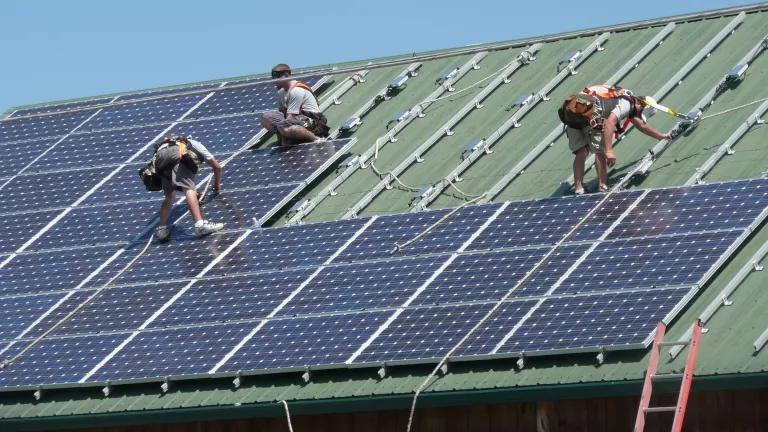Six Sovereigns Achieve Pathway to Snake River Dam Retirement
The historic agreement is a major step forward to create a more equitable and balanced future for tribes of the Pacific Northwest.

The Dalles Dam flooded Celilo Falls and Celilo Village on March 10, 1957.
Josué Rivas for NRDC
After three decades of litigation and two years of negotiations, the Nez Perce Tribe, the state of Oregon, and environmental plaintiffs have reached a groundbreaking agreement in the case challenging the U.S. government’s operations of the federal hydropower dams for violation of the Endangered Species Act. NRDC is a party to the case by way of its membership in the Northwest Energy Coalition. The parties agreed to stay the litigation for five years in exchange for a set of commitments by the U.S. government:
- To restore abundant and harvestable levels of salmon
- Build out at least 10 new tribally sponsored clean energy projects and stand up a first-of-its-kind Tribal Energy Sovereignty program
- To invest an amount that, when combined with other recent funding, will commit more than $1 billion to improving watershed quality, hatcheries management, and habitat for salmon and other wildlife
- To pave the way for lower Snake River restoration and dam removal
“Today’s historic agreement marks a new direction for the Pacific Northwest,” said John Podesta, senior advisor to the president for Clean Energy Innovation and Implementation. “Today, the Biden-Harris administration and state and tribal governments are agreeing to work together to protect salmon and other native fish, honor our obligations to tribal nations, and recognize the important services the Columbia River System provides to the economy of the Pacific Northwest.”
“At every step of the way, tribes will continue to have a seat at the table and be integral in our efforts to restore and protect these precious ecosystems,” promised Secretary of the Interior Deb Haaland in the White House press release that was joined by leaders of four Columbia River tribes.
The agreement follows a Presidential Memorandum issued earlier this year that directed federal agencies to prioritize the restoration of healthy and abundant salmon, steelhead, and other native fish populations in the Columbia River Basin.

Keyen Singer and her mother Cara Green are members of the Confederated Tribes of Umatilla Indian Reservation and descend from a long line of fishers forced to fight for the survival of salmon.
Michael Hanson for NRDC
The agreement’s framework comes from a remarkable Columbia Basin Restoration Initiative roadmap recently sent to the White House by the Six Sovereigns: the state of Oregon, the state of Washington, the Confederated Tribes and Bands of the Yakama Nation, the Confederated Tribes of the Umatilla Indian Reservation, the Confederated Tribes of the Warm Springs Reservation, and the Nez Perce Tribe. The Restoration Initiative takes an honest look at this region’s hard history—especially the impact that past development, in particular hydropower, has had on the region’s Indigenous Peoples and the ecosystem—and charts a set of actions that will achieve a more equitable and balanced future.
“For too long we have seen the federal government try to do the minimum amount necessary to pass legal muster under the Endangered Species Act,” said Jonathan W. Smith, Sr., Warm Springs tribal council chairman. “This minimum-effort approach has resulted in our fish populations limping along at depressed levels, oftentimes near extinction and leaving us without enough salmon for our ceremonies, culture, and subsistence.”
The Restoration Initiative’s stated aim is to “bring forward the tribal people and fisheries left behind in the rush of development” and to restore salmon, steelhead, and other native species in the basin. “Only with bold leadership can we collectively create a future for the Northwest where ecological and cultural resiliency are embraced as a key component of economic prosperity, rather than a casualty of it,” the Restoration Initiative explains.
The detailed actions supported by the Six Sovereigns include, among others, estuary and tributary habitat protection and restoration, greater recognition of the role of tribes as comanagers of the fisheries resource, replacement of the services of the lower Snake River dams to enable removal, and plans to address energy siting considerations to help address long-standing tribal inequities and minimize ecological harm.
The agreement makes investments to advance all these actions, including a commitment to facilitate the buildout of at least 1–3 gigawatts of tribally sponsored renewable energy production. The agreement addresses energy affordability both by avoiding potentially significant rate increases from court-ordered dam operations and by increasing the amount of water available to Bonneville Power during a high energy demand time of the summer.

A young girl stands at an "in lieu" site, which were created after the construction of dams flooded tribal villages and fishing sites and displaced citizens of the Columbia Basin's tribes.
Josué Rivas for NRDC
The road ahead is long. There is a tremendous amount of work to be done. But the significance of achieving a comprehensive path forward for salmon recovery in the Columbia River Basin that is supported by the Six Sovereigns and U.S. government is hard to overstate.
Since 1994, federal judges have looked at this issue and rejected the government’s proposed operations of the 14 federal dams on the Columbia and Snake Rivers. Time after time, three different federal judges have found that the dams violate the Endangered Species Act and jeopardize the future existence of salmon. U.S. District Court Judge Malcom Marsh characterized the government’s efforts as “small steps, minor improvements and adjustments—when the situation literally cries out for a major overhaul.”
We are now looking at that overdue major overhaul. The partnering of the Six Sovereigns, federal government, and environmental and other partner groups would not have been possible without the momentum built tirelessly by the regions tribes.
Last month, representatives from more than 15 tribes, state and federal government officials, and conservation NGO leaders gathered on the Tulalip Indian Reservation at the Rise Up Northwest in Unity event that put a spotlight on the joint struggle to safeguard salmon from extinction. In the words of Nez Perce Chairman Shannon Wheeler, “It’s a massive movement in salmon recovery right now.” For the Northwest tribes, he said they are working “so that the salmon have a chance, the steelhead have a chance, the lamprey have a chance, the orca have a chance, and we as Native people have a chance.”
Amy Cordalis, an attorney for the Yurok Tribe and executive director of Ridges to Ripples, spoke at that event about her experience fighting for the restoration of the Klamath River and removal of the Klamath River dams. “We have already come so far. We have already begun that process of healing from colonization, healing from genocide, healing from assimilation,” she said. And now, she explained, we are entering “into the next era of healing where we restore the balance between the natural world and the people. And that absolutely has to be led by the Indigenous Peoples because we are the ones that have lived for millennia in that balance.”
Reaching this agreement is a huge achievement. We now have a roadmap to recovery and a first-of-its-kind commitment by the U.S. government to work with the Six Sovereigns on shared aims and actions. And the urgency to act is real. Thirteen Columbia Basin salmon populations remain in critical danger of extinction. We have a lot of hard work in front of us to build a cleaner, more equitable, and abundant future.
This blog provides general information, not legal advice. If you need legal help, please consult a lawyer in your state.




